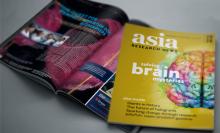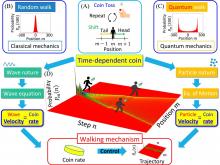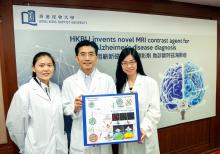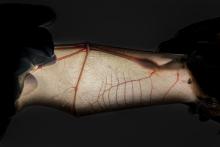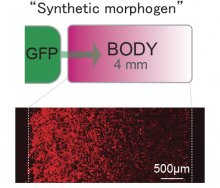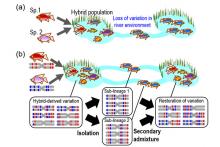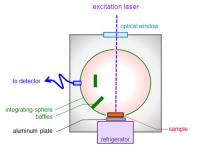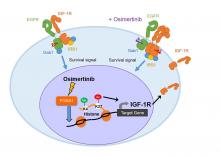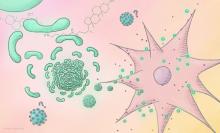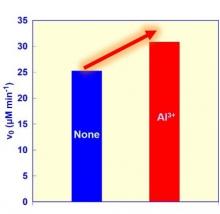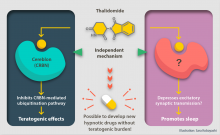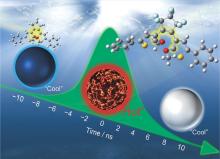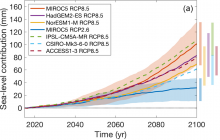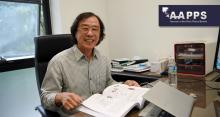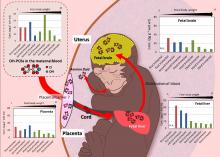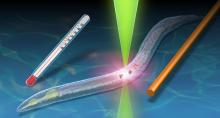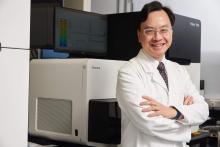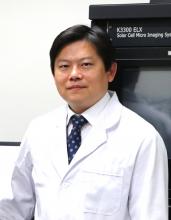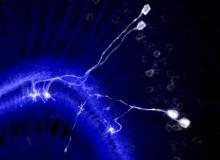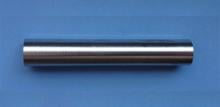Science
News
30 Oct 2020
A research team based in Japan may be moving toward a more controlled walk by unveiling the mechanism underlying the directional decision of each quantum step and introducing a way to potentially control the direction of movement.
28 Oct 2020
Hong Kong Baptist University (HKBU) scientists have invented a novel contrast agent for magnetic resonance imaging (MRI), which enables real-time visualisation and detection of the size and number of amyloid-beta in the brain, a main hallmark of Alzheimer’s disease (AD). The invention offers hope for early detection and large-scale routine screening of AD. It can also help to assess the efficacy of drugs used to treat it.
26 Oct 2020
Study confirms bats adopt multiple strategies to reduce pro-inflammatory responses, thus mitigating potential immune-mediated tissue damage and disease. Findings provide important insights for medical research on human diseases.
20 Oct 2020
Researchers at Kanazawa University and University of California, San Francisco report in Science that arbitrary proteins, when combined with anchoring and receptor proteins, can work as a signaling protein “morphogen” capable of engineered spatial patterning.
07 Oct 2020
Adaptive radiation - the rapid evolution of many new species from a single ancestor - is a major focus in evolutionary biology. Adaptive radiations often show remarkable repeatability where lineages have undergone multiple episodes of adaptive radiation in distant places and at various points in time - implying their extraordinary evolutionary potential.
06 Oct 2020
Tohoku University researchers have improved a method for probing semiconducting crystals with light to detect defects and impurities. The details of their 'omnidirectional photoluminescence (ODPL) spectroscopy' set-up were published in the journal Applied Physics Express, and could help improve the fabrication of materials for electric cars and solar cells.
06 Oct 2020
Researchers at Kanazawa University report in Nature Communications the mechanism making some lung-cancer patients resistant to the drug osimertinib. In addition, they suggest a combined drug treatment resolving osimertinib resistance in the case of cancer cells expressing low amounts of AXL, a protein belonging to the class of receptor tyrosine kinases.
01 Oct 2020
Scientists have found an ingredient that makes a vaccine more effective through an approach more often seen in materials science – testing molecules that self-assemble into larger structures.

01 Oct 2020
A Hokkaido University research group has successfully demonstrated that carbon-carbon (C-C) covalent bonds expand and contract flexibly in response to light and heat. This unexpected flexibility of C-C bonds could confer new properties to organic compounds.
29 Sep 2020
Researchers at Osaka City University produce malic acid, which contains 4 carbon atoms, through artificial photosynthesis by simply adding metal ions like aluminum and iron. This solves a problem with current artificial photosynthesis technology of only producing molecules with 1 carbon atom and paves the way to exploring the use of CO2 as a raw material.
28 Sep 2020
Researchers from the University of Tsukuba demonstrate that the hypnotic and teratogenic effects of thalidomide are separable.
Thalidomide is a medication with several different effects, one of which is promoting sleep in the context of insomnia. In a new study, researchers from the University of Tsukuba have discovered that thalidomide exerts its hypnotic effects through mechanisms distinct from those for the drug’s notorious teratogenicity.
These are striking results showing how thalidomide induces sleep independently of its known effects on the teratogenic cereblon pathway. These findings could be helpful in developing novel thalidomide-like hypnotic drugs without thalidomide’s teratogenic effects.
The study was published in the scientific journal Proceedings of the National Academy of Sciences of the United States of America.
25 Sep 2020
Researchers at Osaka City University create a quantum algorithm that removes spin contaminants while making chemical calculations on quantum computers. This allows for predictions of electronic and molecular behavior with degrees of precision not achievable with classical computers and paves the way for practical quantum computers to become a reality.
25 Sep 2020
An Ehime University group led by Dr. Ishibashi and Prof. Asahi reported that when a nanosecond laser pulse was irradiated to diarylethene nanoparticles which show the photo-induced isomerization reaction from the colored closed-form to the colorless open-form, the ring-opening reaction was at most 80 times more effective than that in the solution phase. The amplification could be well explained as a ‘photosynergetic effect’ coupled with nanoscale photothermal conversion and a photochemical reaction. There are very few reports of such a nanosecond laser pulse induced amplified photochemical reaction in nanoparticles, indicating a new photoenergy conversion method.
17 Sep 2020
An international consortium of researchers under the aegis of CMIP6 has calculated new estimates for the melting of Earth’s ice sheets due to greenhouse gas emissions and its impact on sea levels, showing that the ice sheets could together contribute more than 40 cm by the end of 2100.
16 Sep 2020
Applying cutting-edge experimental and computational tools to basic science, researchers in Australia and Singapore have discovered a technique that could enable future cell therapies for placenta complications during pregnancy.
16 Sep 2020
Professor Hyeon K. Park, affiliated with South Korea's Ulsan National Institute of Science and Technology (UNIST) has been selected, as the 7th Laureate of S. Chandrasekhar Prize of Plasma Physics.
15 Sep 2020
A team of scientists has unraveled the molecular mechanism behind one of the causes of colorectal cancer, and a treatment target.
14 Sep 2020
Scientists at Daegu Gyeongbuk Institute of Science and Technology, Korea, show that it is possible to distinguish between left-handed and right-handed people by noninvasively monitoring just their brain activity during passive tactile stimulation. These results are key in haptic research (the study of sensory systems) and have various important implications for brain–computer interfaces, augmented reality, and even artificial intelligence.
14 Sep 2020
This study selected the Japanese macaque (Macaca fuscata) as a model animal for the fetal transfer of OH-PCBs in humans, and revealed OH-PCB concentrations and their relationships in the maternal and fetal brains. The key finding from this study is that OH-PCBs can reach the developing brain of the fetus as early as the first trimester of pregnancy. These OH-PCBs may exceed the levels that induce adverse effects on neurodevelopment.
11 Sep 2020
Measuring the temperature of objects at a nanometer-scale has been a long challenge, especially in living biological samples, because of the lack of precise and reliable nanothermometers. An international team of researchers has realized a quantum technology to probe temperature on a nanometer-scale, and have observed a ‘fever’ in tiny nematode worms under pharmacological treatment. This strengthens the connection between quantum sensing and biology and ushers in novel thermal imaging technologies in biomedical research.
11 Sep 2020
Professor Dennis Yuk Ming LO from the Faculty of Medicine at The Chinese University of Hong Kong (CU Medicine) was just announced as a winner of The 2021 Breakthrough Prize in Life Sciences for discovering that fetal DNA is present in maternal blood and can be used for the prenatal testing of Down syndrome and a variety of genetic diseases. Professor Lo’s prenatal testing technology is now performed over 7 million times annually with women in over 90 countries. The Breakthrough Prize, renowned as the “Oscars of Science”, aims to honour paradigm shifting research in the categories of Fundamental Physics, Life Sciences and Mathematics and was created and funded by founders of a number of leading enterprises in the global technology sector in 2012. The awardees are nominated in an open online process. Each laureate receives US$3 million (equivalent to HK$24 million) in prize money, which is the most generous science award to date and attracts considerable attention in the global scientific community.
09 Sep 2020
Scientists at Daegu Gyeongbuk Institute of Science and Technology, Korea, develop a novel “heterostructured” photocatalyst using titanium and copper, two abundant and relatively inexpensive metals. Their cost-effective synthesis procedure, coupled with the high stability of the photocatalyst, provides an economically feasible way to convert waste carbon dioxide and water into useful hydrocarbon fuels using endless sunlight.
07 Sep 2020
Researchers at Kanazawa University report in Nature Communications the discovery that in the developing fly brain, neurons stemming from the same parent cell experience repulsion. This lineage-dependent repulsion is regulated by a protein known as Dscam1.
07 Sep 2020
Scientists are learning about species adaptation by comparing their stem cell-related genes.
26 Aug 2020
Duke-NUS, the only graduate-entry medical school in Singapore, has joined the TriNetX global research network to increase clinical trial adoption and to facilitate better collaboration with other global healthcare organizations (HCOs). This latest member for TriNetX in Asia will provide the network with access to de-identified data from more than a million patients.
20 Aug 2020
A new catalyst design enables unprecedented control over the modification of fatty acid derivatives that opens the door to creating useful substances in a green and efficient manner.
20 Aug 2020
The ever-increasing workload of data centers calls for new ways to store and access data. Researchers from the Daegu Gyeongbuk Institute of Science and Technology, Korea, have developed a new approach to manage databases in solid state drives, providing marked performance improvements in read/write delays and offloading database computation tasks from CPUs to increase efficiency and reduce power consumption.
20 Aug 2020
Researchers from Tohoku University’s Graduate School of Engineering have discovered a novel iron-based superelastic alloy capable of withstanding extreme temperatures—both high and low.
Giants in history
Chinese biochemist Chi Che Wang (1894 - 1979), one of the first Chinese women to study abroad, advanced to prominent research positions at American institutions including the University of Chicago and the Northwestern University Medical School.
Ruby Sakae Hirose (1904 – 1960) was a Japanese-American scientist whose research contributed significantly to our understanding of blood clotting, allergies and cancer.
Chinese electron microscopy specialist Li Fanghua (6 January 1932 – 24 January 2020) facilitated the high-resolution imaging of crystal structures by eliminating interference.
Sálim Moizuddin Abdul Ali (12 November 1896 – 20 June 1987), commonly referred to as the Birdman of India, was the first person to conduct systematic surveys of birds from across India.
Haisako Koyama (1916 – 1997) was a Japanese solar observer whose dedication to recording sunspots – cooler parts of the sun’s surface that appear dark – produced a sunspot record of historic importance.
Michiaki Takahashi (17 February 1928 – 16 December 2013) was a Japanese virologist who developed the first chickenpox vaccine.
Toshiko Yuasa (11 December 1909 – 1 February 1980) was the first Japanese female physicist whose research on radioactivity shed light on beta decay – the process in which an atom emits a beta particle (electron) and turns into a different element.
Angelita Castro Kelly (1942-2015) was the first female Mission Operations Manager (MOM) of NASA. She spearheaded and supervised the Earth Observing System missions during its developmental stage.
Malaysia’s first astrophysicist, Mazlan binti Othman (born 11 December 1951) was instrumental in launching the country’s first microsatellite, and in sending Malaysia’s first astronaut, Sheikh Muszaphar Shukor, into space.
Known as Mr. Natural Rubber, chemist and researcher B. C. Shekhar (17 November 1929 – 6 September 2006) introduced a number of technical innovations that helped put Malaysia’s natural rubber industry on the world map.
Shinichiro Tomonaga (31 March 1906 – 8 July 1979), together with Richard Feynman and Julian Schwinger, was awarded the Nobel Prize in Physics in 1965, for their contributions to advance the field of quantum electrodynamics. Tomonaga was also a strong proponent of peace, who actively campaigned against the proliferation of nuclear weapons and promoted the peaceful use of nuclear energy.
South Korean theoretical physicist Daniel Chonghan Hong (3 March 1956 – 6 July 2002) achieved fame in the public sphere through his research into the physics of popcorn.
Japanese chemist Kenichi Fukui (4 October 1918 – 9 January 1998) was the first Asian scientist to be awarded the Nobel Prize in Chemistry. Together with Roald Hoffman, he received this honour in 1981 for his independent research into the mechanisms of chemical reactions.
Chinese palaeontologist, archaeologist and anthropologist Pei Wenzhong (January 19, 1904 – September 18, 1982) is regarded as a founder of Chinese anthropology.
Physicist Narinder Singh Kapany (31 October 1926 – 4 December 2020) pioneered the use of optical fibres to transmit images, and founded several optical technology companies. Born in Punjab, India, he worked at a local optical instruments factory before moving to London for PhD studies at Imperial College. There, he devised a flexible fibrescope to convey images along bundles of glass fibres.
Japanese physicist Ukichiro Nakaya (1900-1962) made the world’s first artificial snowflakes. He started his research on snow crystals in the early 1930s at Hokkaido University, where there is an unlimited supply of natural snow in winter. By taking over 3,000 photographs, he established a classification of natural snow crystals and described their relationship with weather conditions.
The field of solid-state ionics originated in Europe, but Takehiko Takahashi of Nagoya University in Japan was the first to coin the term ‘solid ionics’ in 1967. ‘Solid-state ionics’ first appeared in 1971 in another of his papers, and was likely a play on ‘solid-state electronics’, another rapidly growing field at the time.
Charles Kuen Kao (Nov. 4, 1933 to Sept. 23, 2018) was an engineer who is regarded as the father of fibre optics. His work in the 1960s on long distance signal transmission using very pure glass fibres revolutionized telecommunications, enabling innovations such as the Internet.
Chika Kuroda (24 March 1884 – 8 November 1968) was a Japanese chemist whose research focussed on the structures of natural pigments.
Motoo Kimura (13 November 1924 – 13 November 1994) was a Japanese theoretical population geneticist who is best remembered for developing the neutral theory of molecular evolution.
Meghnad Saha (6 October 1893 – 16 February 1956) was an Indian astrophysicist best known for formulating the Saha ionization equation which describes the chemical and physical properties of stars.
Sir Jagadish Chandra Bose (30 November 1858 – 23 November 1937) was a scientist and inventor who contributed to a wide range of scientific fields such as physics, botany and biology.
Osamu Shimomura (27 August 1928 – 19 October 2018) was a Japanese organic chemist and marine biologist who dedicated his career to understanding how organisms emitted light.
Subrahmanyan Chandrasekhar (19 October 1910 – 21 August 1995) was an Indian astrophysicist who studied the structure and evolution of stars.
Joo-myung Seok (November 13, 1908 – October 6, 1950) was a Korean butterfly entomologist who made important contributions to the taxonomy of the native butterfly species in Korea.
Mathematician Maryam Mirzakhani (12 May 1977 – 14 July 2017) was the first and only woman and Iranian to date to win the Fields Medal in 2014 for her work on curved surfaces.
Sir Chandrasekhara Venkata Raman (7 November 1888 – 21 November 1970) was an Indian physicist who performed ground-breaking research in the field of light-scattering.
Mohammad Abdus Salam (29 January 1926 – 21 November 1996) was a theoretical physicist and the first Pakistani to receive a Nobel Prize in science.
Srinivasa Ramanujan (22 December 1887 – 26 April 1920) was a math prodigy and widely considered one of India’s greatest mathematicians. Despite having almost no formal training in mathematics, he made substantial contributions to mathematical analysis, number theory, infinite series and continued fractions.
Gopalasamudram Narayanan Ramachandran (8 October 1922 – 7 April 2001) is best known for developing the Ramachandran plot to understand the structure of short chains of amino acids, known as peptides.
Hitoshi Kihara (1893 – 1986) was one of the most famous Japanese geneticists of the 20th century. One of his most significant contributions was identifying sex chromosomes (X and Y) in flowering plants.
Chien-Shiung Wu (31 May 1912 – 16 February 1997) was an experimental physicist who made several important contributions to nuclear physics. Wu worked on the Manhattan Project – a top-secret program for the production of nuclear weapons during World War II and helped to develop a process for separating uranium into U235 and U238.
Meemann Chang (born 17 April 1936) is a Chinese palaeontologist who studied the fossils of ancient fish to understand the evolution of life. By examining fossils, she uncovered new insights on how vertebrates, animals with a backbone, migrated from the sea and became adapted to live on land.
Bibha Chowdhuri (1913 – 2 June 1991) was an Indian physicist who researched on particle physics and cosmic rays. In 1936, she was the only female to complete a M.Sc. degree at the University of Calcutta.
Lin Lanying (7 February 1918 – 4 March 2003) was a Chinese material engineer remembered for her contributions to the field of semiconductor and aerospace materials. Lanying was born into a family who did not believe in educating girls and she was not allowed to go to school.
Japanese geochemist Katsuko Saruhashi developed the first method and tools for measuring carbon dioxide in seawater


